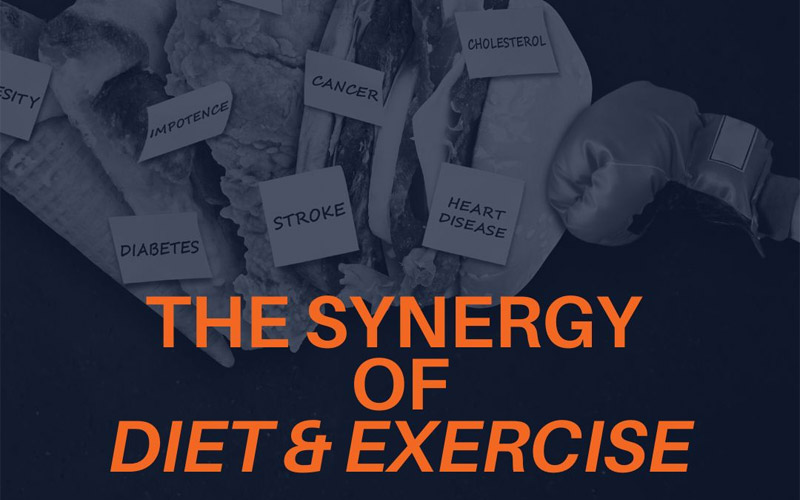As an ACE Certified Health Coach and NFPT-CPT, I spend a considerable amount of time talking and coaching my clients to improve their health and wellness. In addition to this, I also like to dive into the science of how and why living an active lifestyle and practicing balanced, mindful nutrition is important. Quality research studies show that the synergy of nutrition and physical activity reduces the risk of developing chronic conditions such as diabetes, metabolic syndrome, and obesity.
As a result of that passion for practice and research, I spent the last two years, working on a systematic review and meta-analysis with practitioners from various universities representing the fields of dietetics and exercise science, and the Academy of Nutrition and Dietetics. Our research was officially published in Nutrients (April 2022), and the results are applicable to dietitians, health coaches, personal trainers, and other allied health professionals.
The Purpose of Nutrition and Physical Activity Interventions
Our objective in coming together as an allied health team was to answer the question: What are the effects of nutrition and physical activity interventions (provided by nutrition and exercise practitioners) on defined behavioral and anthropometric outcomes and quality of life?
As professionals representing our respective fields, we work with clients regularly who are apparently healthy or who have cardiometabolic risk factors. However, we wanted to better understand how a combined intervention using both exercise and nutrition practitioners might impact physical activity habits, fruit and vegetable intake, waist circumference, weight loss, quality of life, and adverse events.
The Process
Research began in January 2021 after our research team determined the study criteria we wanted to include in the meta-analysis. Studies were then limited to the selected criteria along with reporting at least one outcome of interest (such as reduced waist circumference or improved fruit and vegetable intake). All studies examined were published in January 2010 or later.
The research team was interested in including studies that had all four of the following characteristics.
- The participants in each study were 18 or older, considered healthy (free of diagnosed diseases) or had risk factors for developing cardiovascular or metabolic conditions.
- Examined risk factors included overweight, obesity, and/or impaired glucose tolerance, diabetes risk, or pre-hypertension.
- Interventions in the examined studies had to include both nutrition and physical activity components, last at least a month in duration, and be delivered by nutrition and/or certified exercise and/or health coaching professionals.
- Nutrition practitioners were defined as registered dietitians or international equivalents. Qualified exercise practitioners were personal trainers, exercise physiologists, and those with other professional certifications recognized by the United States Registry of Exercise Professionals. Health coaches were identified by the authors’ definition.
In addition to the study criteria, each study included had to focus on at least one outcome of interest related to the interventions outlined in each study, or a variable present in each study that we wanted to better understand. Those included:
- How long were people asked to exercise? How challenging was the activity?
- What was their fruit and vegetable intake?
- What was their waist circumference?
- What was the percentage of weight loss experienced by people who were medically diagnosed as affected by overweight or obesity?
- How was their overall quality of life?
- Were there any adverse events people experienced during the experiment?
The Results
After extensive analysis, our research team discovered when qualified professionals combined nutrition and physical activity interventions for their clients, clients had a higher likelihood of:
- increasing their physical activity
- consuming more fruits and vegetables
- decreasing their waist circumference
- improving their odds of achieving a 5% weight loss (if affected by overweight or obesity) versus people who did not receive these interventions.
What this means for us as Certified Personal Trainers
This review serves to confirm that nutrition and physical activity are powerful predictors of health and that, when combined, have a unique power to change the trajectory of someone’s life. This means exercise professionals, health coaches, and dietitians (or other allied health professionals) should prioritize building their partnerships with each other to elevate the client experience and, thereby, increase the client’s success rate.
The best intervention is one that focuses on helping clients change lifestyle habits by harmonizing the various components of their lives and placing physical activity and balanced nutritional practices at the top of the priority list. If an individual feels better, their life is improved by leaps and bounds. In case you. needed additional confirmation of how important the work you do is, this analysis provides such validation.
Dr. Erin Nitschke, NFPT-CPT, NSCA-CPT, ACE Health Coach, Fitness Nutrition Specialist, Therapeutic Exercise Specialist, and Pn1 is a health and human performance college professor, fitness blogger, mother, and passionate fitness professional. She has over 15 years of experience in the fitness industry and college instruction. Erin believes in the power of a holistic approach to healthy living. She loves encouraging her clients and students to develop body harmony by teaching focused skill development and lifestyle balance. Erin is also the Director of Educational Partnerships & Programs for the NFPT. Erin is an editorial author for ACE, IDEA, The Sheridan Press, and the Casper Star Tribune. Visit her personal blog at belivestaywell.com


